
Setarchinae, the deep-sea bristly scorpionfishes, is a small subfamily of deep-sea ray-finned fishes, it is part of the family Scorpaenidae. They are small marine fishes, growing up to 25 cm, and are found in tropical and subtropical waters throughout the world.

Scorpaenodes is a widespread genus of marine ray-finned fish belonging to the family Scorpaenidae, the scorpionfishes. The fishes in this genus are found to the Atlantic, Indian and Pacific Ocean.

Pontinus is a genus of marine ray-finned fish belonging to the family Scorpaenidae, the scorpionfishes. The scorpionfishes in this genus are distributed in the tropical and warm temperate parts Atlantic, Indian and Pacific Oceans.

Macolor is a genus of marine ray-finned fish, snappers belonging to the family Lutjanidae. They are native to the Indian Ocean and the western Pacific Ocean.
The spotfin scorpionfish is a species of marine ray-finned fish belonging to the family Scorpaenidae, the scorpionfishes. It is known from the western Indian Ocean This species is the only known member of the genus Neoscorpanea.

Sebastolobus, the thornyheads, is a genus of marine ray-finned fish belonging to the subfamily Sebastinae, the rockfishes, part of the family Scorpaenidae. These fishes are native to the northern and eastern Pacific Ocean. They are generally found in deep waters.

Rhinopias frondosa, the weedy scorpionfish or the weed fish, is a species of marine ray-finned fish belonging to the family Scorpaenidae, the scorpionfishes. This species is found in the Indo-West Pacific. It is a rare but highly desirable fish in the aquarium trade.

Parascorpaena picta, the northern scorpionfish, painted scorpionfish or marbled rock cod is a species of marine ray-finned fish belonging to the family Scorpaenidae, the scorpionfishes. This species is native to the Indian Ocean and the western Pacific Ocean. This species grows to a length of 16 centimetres (6.3 in) TL.
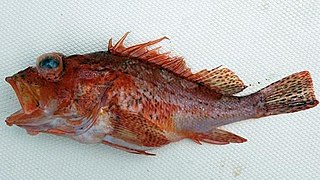
Pontinus furcirhinus, one of a number of species known as the "red scorpionfish", is a species of marine ray-finned fish belonging to the family Scorpaenidae, the scorpionfishes. It is found in the eastern Pacific Ocean.
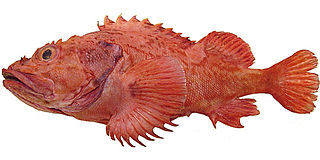
Adelosebastes is a monotypic genus of marine ray-finned fish belonging to the subfamily Sebastinae, the rockfishes, part of the family Scorpaenidae. The only species in this genus is Adelosebastes latens, the Aleutian scorpionfish. It is found in the northern Pacific Ocean.
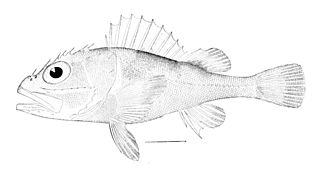
Trachyscorpia is a genus of marine ray-finned fish belonging to the subfamily Sebastinae, the rockfishes, part of the family Scorpaenidae. The species in this genus are found in the Atlantic, Indian and Pacific oceans.
Lioscorpiusis a genus of marine ray-finned fish, belonging to the subfamily Setarchinae, the deep-sea bristly scorpionfishes, part of the family Scorpaenidae. They are native to the western Pacific Ocean.
Choridactylus is a genus of marine ray-finned fishes, it is one of two genera in the tribe Choridactylini, one of the three tribes which are classified within the subfamily Synanceiinae within the family Scorpaenidae, the scorpionfishes and their relatives. They are commonly known as stingfishes. They are found in the Indo-West Pacific.

Chaetodipterus is a genus of marine ray-finned fishes belonging to the family Ephippidae, the spadefishes. These fishes are found in the Atlantic and eastern Pacific Oceans.

Sebastolobus macrochir, the broadbanded thornyhead or broadfin thorny head, is a species of marine ray-finned fish belonging to the subfamily Sebastinae, the rockfishes, part of the family Scorpaenidae. It is found in deep waters of the northwestern Pacific Ocean.
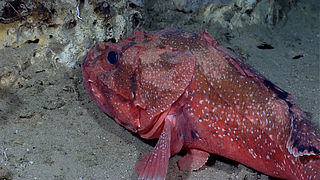
The Atlantic thornyhead is a species of marine ray-finned fish belonging to the subfamily Sebastinae, the rockfishes, part of the family Scorpaenidae. It is found in the western Atlantic Ocean and the Caribbean Sea.

Lythrichthys, the red deepwater scorpionfishes, is a genus of marine ray-finned fish, belonging to the subfamily Setarchinae, the deep-sea bristly scorpionfishes, part of the family Scorpaenidae. They are native to the Pacific Ocean.
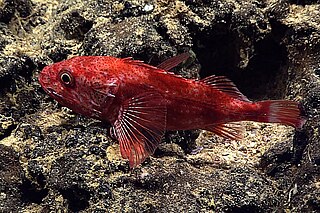
The channelled rockfish, commonly known as the deepwater scorpionfish, is a marine ray-finned fish belonging to the subfamily Setarchinae, which is a part of the family Scorpaenidae. This species is found in various tropical and subtropical oceans and has a wide distribution.

The filamentous scorpionfish is a species of marine ray-finned fish belonging to the family Scorpaenidae, the scorpionfishes. It is found in the Indo-West Pacific. It is the only species in the monotypic genus Hipposcorpaena.

Scorpaenodes guamensis, the Guam scorpionfish or common scorpionfish, is a species of venomous, marine, ray-finned fish belonging to the family Scorpaenidae, the scorpionfishes. It has a wide Indo-Pacific distribution.
















